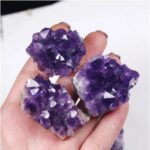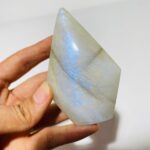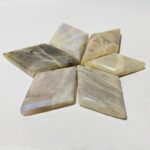Embark on an otherworldly adventure as we delve into the captivating world of UV reactive rocks. These enigmatic stones possess an astonishing secret: they burst into vibrant hues under the beam of ultraviolet light, painting ethereal designs that ignite the imagination. Join us as we unravel the scientific marvel behind these cosmic treasures and explore their myriad applications.

Uncovering the Science of UV Reactivity
UV reactive rocks are adorned with fluorescent minerals that absorb ultraviolet radiation and emit visible light in response. The specific mineral composition determines the rock’s unique color palette. For instance, minerals containing manganese emit a fiery orange, while those with uranium glow an otherworldly green.
According to the United States Geological Survey, over 30 different minerals exhibit UV reactivity. The most common types include:
| Mineral | UV Color |
|---|---|
| Scheelite | Blue |
| Calcite | Yellow, Orange |
| Fluorite | Blue, Green, Purple |
| Willemite | Green, Yellow |
| Opal | Red, Orange, Yellow |
Applications of UV Reactive Rocks
The mesmerizing beauty of UV reactive rocks has sparked countless applications, from artistic creations to scientific research. Let’s delve into some of their most captivating uses:
-
Art Installations: UV reactive rocks have become a popular material for captivating art installations in museums, galleries, and public spaces. The ethereal glow of these stones transforms ordinary environments into extraordinary realms of light and color.
-
Jewelry and Accessories: The dazzling radiance of UV reactive rocks has made them highly sought after for jewelry and accessories. Earrings, necklaces, and rings adorned with these stones illuminate with a mesmerizing glow under UV light, beckoning attention and admiration.
-
Geologic Research: UV reactive rocks play a pivotal role in geologic research. By studying the fluorescence of minerals, scientists can identify mineral deposits, understand rock formations, and unravel the history of the Earth’s crust.
-
Forensic Science: UV reactive rocks offer valuable assistance in forensic investigations. Certain substances, such as blood and bodily fluids, can fluoresce under UV light, providing crucial clues in criminal cases.
Strategies for Enhanced UV Reactivity
To maximize the vibrancy and intensity of UV reactivity, consider these effective strategies:
-
Use High-Power UV Lights: Invest in a quality UV lamp with sufficient power to produce a strong beam. This will elicit the brightest and most vivid fluorescence from the rocks.
-
Darken the Environment: Create a pitch-black environment to minimize ambient light interference and enhance the contrast of the fluorescent glow.
-
Experiment with Different Angles: Experiment with illuminating the rocks from various angles to highlight different mineral compositions and create stunning patterns.
-
Consider Magnification: For intricate details and smaller rocks, consider using a magnifying glass or microscope. This will reveal hidden nuances and enhance the aesthetic appeal of the fluorescence.
Tips and Tricks for Handling UV Reactive Rocks
To ensure the longevity and safety of your UV reactive rocks, follow these useful tips:
-
Handle with Care: UV reactive rocks are often fragile, so handle them with care to avoid damage. Use gloves to prevent skin contact with fluorescent minerals.
-
Store in Darkness: When not in use, store UV reactive rocks in a dark, dry place to prevent fading and degradation.
-
Avoid Direct Sunlight: Prolonged exposure to direct sunlight can damage the fluorescent minerals, so avoid placing these rocks in windows or direct sunlight for extended periods.
-
Clean Sparingly: If necessary, clean UV reactive rocks with a soft, damp cloth. Avoid harsh chemicals or abrasive cleaners.
Common Mistakes to Avoid
To avoid disappointment or damage to your UV reactive rocks, heed these common mistakes:
-
Using Low-Power UV Lights: Inadequate UV light intensity can result in weak or faint fluorescence. Ensure you have a sufficiently powerful UV lamp.
-
Overexposing to UV Light: Excessive exposure to UV light can degrade the fluorescent minerals and diminish their radiance. Limit exposure time and intensity to preserve the rocks’ beauty.
-
Storing in Sunlight: Exposure to sunlight can cause the fluorescent pigments to fade and weaken over time. Store your rocks in darkness to maintain their vibrant glow.
-
Handling with Bare Hands: Direct skin contact can transfer oils and acids to the rocks, potentially interfering with their fluorescence. Use gloves when handling these stones.
Conclusion
UV reactive rocks are a captivating phenomenon that ignite our imaginations and inspire awe with their ethereal glow. By understanding the science behind their fluorescence and embracing creative applications, we can harness their extraordinary beauty to elevate art, advance scientific research, and create unforgettable experiences. Remember to handle these rocks with care and adhere to the recommended tips and tricks to ensure their longevity and preserve their captivating radiance. Let the cosmic canvas of UV reactive rocks illuminate your world and transport you to realms of wonder and inspiration.




























